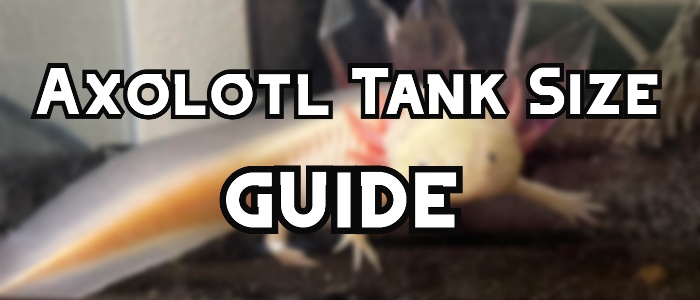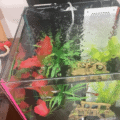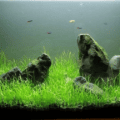Axolotl’s are exotic pets to keep and are known to be one-of-a-kind. If you’re looking to expand your expertise on unique pets, then this ever-smiling amphibian is the way to go!

Originating from the freshwater lakes of Mexico, such as Lake Chalco, axolotls are unique aquatic salamanders that maintain their juvenile form throughout their lives.
Recently, the axolotl has captured the hearts of aquarists and enthusiasts. This amphibian has some amazing abilities that make it unique; its endearing smile and regenerative abilities are among its unique characteristics that make people fall in love.
Unlike most amphibians, axolotls spend their entire life in water with matured gills, which is why they are called “walking fish.”
Their popularity increased due to their unique features and how easy it is to care for them; their ability to regrow organs makes them fascinating and famous in the medical society. Their calm behavior also makes them great pets for beginners.
However, you need to know the right tank size for your new axolotl pet; the number of axolotls you intend to keep determines the tank size you’ll use. A 10-gallon aquarium will be suitable for juvenile axolotls, but they’ll need to be relocated once they have matured.
Tank size plays a crucial role in their health and happiness. Axolotl care is greatly affected by the tank size, which is why it is a crucial aspect to take into consideration.
What is an Appropriate Axolotl Tank Size?

Axolotl tank requirement is a major topic when it comes to caring for axolotl; there are different opinions on the right tank size, some may say a 10 or 15-gallon tank is appropriate, but it depends on the age, number, and size of the axolotl.
These salamanders spend their entire life in water, which means they require pristine water conditions and lots of space to survive. Keeping them in subpar conditions stresses them, thus reducing their life span.
A full-grown axolotl requires a minimum tank size of 20 gallons; the axolotl per tank ratio should be one axolotl per 20-gallon tank, so if you have three axolotl, you’ll need a 60-gallon tank.
They need a lot of space, which means more water; the large volume of water only dilutes waste and makes maintenance much more straightforward. Most axolotl have a lifespan of 10 years, but with proper space and water conditions, they can live for as long as 20 years.
If you want to enjoy the company of your new pet, it is better to house them in a bigger tank. Keep in mind the right tank size for multiple axolotls; you don’t want to keep them in a cramped space.
Common Tank Size Mistakes
The major mistake newbies make when getting an axolotl tank is thinking that they don’t require that much space due to their size; however, the tank size greatly affects how big an axolotl can grow. An axolotl’s average size and weight are 9 inches (22.9cm) and 0.4 lbs (181 grams).
However, if they’re kept in a bigger tank, they can grow to tremendous sizes, so placing them in a tank smaller than 20 gallons will stunt their growth.
There’s also the argument of a vertical vs horizontal tank; axolotls tend to swim at the bottom of the tank, so a low, wide tank will be more suitable than a narrow, high tank. A horizontal tank will allow them to explore the floor space of their tank better than a vertical option.
Axolotls have permeable skin and produce a lot of ammonia, so slight changes in the water parameters significantly affect them; an overstocked axolotl tank will allow the ammonia and nitrate levels to spike, causing stress to your pets. An axolotl cramped tank can make them less active, and they could become hostile to each other.
Another mistake to avoid is choosing a funny-shaped tank; they might seem aesthetically pleasing, but they’re not practical for axolotls. Forcing them to swim around weird-shaped corners should be avoided.
See more on unique axolotl color varieties to find the perfect pet for your aquarium.
The Ideal Axolotl Tank Setup

Setting an axolotl tank should not be daunting, but there are minor details you need to pay attention to in order to avoid missteps.
In the wild, axolotls spend a lot of time at the bottom of the water body they reside in, so an axolotls aquarium needs to resemble their natural habitat for them to thrive.
The best axolotl substrate to use is sand, but you can also use gravel as long as they’re in large pieces that they can’t swallow. Axolotls hide in crevices; ensure you provide them with ample places to fit into.
Axolotls are used to water temperatures that exceed 68 degrees, so they don’t need a water heater. It is ideal to keep an axolotl water temperature between 60 – 68 degrees; going above this could lead to health issues. Use a thermometer to ensure the water temperature is kept at a steady rate.
Maintaining Water Parameters

As I mentioned earlier, the semi-permeable skin of axolotls makes them susceptible to any changes in the water parameters, so your axolotl’s water quality should remain stable to adverse effects.
Any slight change in the water acidity, temperature, or acidity can significantly affect your axolotl. Fortunately, you can easily maintain these conditions. To maintain an ideal temperature range, you can invest in a chiller but know this is not the norm for most axolotl keepers as this equipment is quite expensive.
The water acidity level should have a pH range of 6.5 – 7.5; it should be slightly acidic, while the water hardness should range between 7-8 dKH.
Using axolotl water conditioners is an easy way to maintain water parameters, but ensure the conditioner doesn’t contain any aloe or iodine, as they are toxic to axolotls.
Conduct frequent axolotl water testing using recommended test kits. Using kits ensures your aquarium’s nitrite, nitrate, and ammonia levels are not spiking.
Setting Up Filtration
Axolotls have evolved to survive in still water, so they do not appreciate strong currents. However, they are well known for the amount of waste they produce, so having a low-flow filter is a must!
It is best to avoid standard canister filters, which produce lots of water movements, but opt for a hang-on-back filter as they are much quieter, cheaper, and easier to find. I recommend buying one with a low-flow head, as it barely disturbs the water, making it one of the best filters for axolotl tanks.
Regardless of your chosen filter, ensure it’s strong enough to cycle the entire aquarium.
Using Plants and Decoration in the Tank

Axolotls naturally stay at the bottom of the tank, so adding live plants would be a great way to add more life to your axolotl tank. However, you need to choose axolotl safe plants they can hide or play in between without reacting adversely. Adding stones and caves gives them a sense of security, allowing them to overcome their timid behavior.
The right axolotl tank decor includes substrate materials like sand, as well as plants such as water wisteria, Anubis, bacopa, and java fern. These plants can withstand cold temperatures and are easy to find.
Upgrading Your Axolotl Tank
If you have multiple axolotl in a tank and they have grown above 7 inches, it is time to upgrade to a bigger axolotl tank. Axolotls need space to thrive, so if you were using a 40-gallon tank for two juvenile axolotls, moving them to a 65-gallon tank might be best.
You’ll know it’s time to upgrade your tank when the waste level increases and you notice you have to perform more frequent water changes. The process of acclimating is important for transferring axolotls to a new tank.
Firstly, dim the light around the aquarium to reduce stress on your pet, place a smaller container into the side of the aquarium to cajole the axolotl to enter, once in that container slowly place the container with the axolotl into the new aquarium, make sure it floats and is not completely submerged in the water.
Slowly add scoops of the new aquarium water into the container for about 45 minutes so your axolotl can acclimate to its new surroundings before releasing it into the new tank.
Using a test kit, make sure the water parameters are stable for axolotl tank cycling. The purpose of placing them in a new tank is for them to thrive, not suffer shock from new water parameters.
Axolotl Tank Cleaning & Maintenance
Maintaining your axolotl’s tank is quite easy, so there’s no need to fret. The best axolotl tank maintenance schedule should include the following steps;
Firstly, remove 25% of the water so that you can maintain the nitrogen cycle of the tank, then use a siphon to remove debris; you can decide to remove your axolotl from the tank or leave them in, but do not disturb the axolotl with the siphon.
Use an aquarium sponge to remove all the algae, and wash any artificial plant in dechlorinated water; after arranging the tank, add water back into the tank, use a water conditioner to remove any chlorine, and ensure the water temperature stays the same throughout the process to avoid shocking your axolotl.
Keeping Tank Mates
If you’re new to aquariums, I would recommend you avoid keeping your axolotl in a community tank. Axolotls thrive better alone, which is why they are best kept alone.
However, they can be kept alongside a few axolotl-compatible fish; an ideal axolotl companion should occupy the top column of the tank and be quick enough to avoid any attacks. Axolotls will try to eat any creature in their line of sight.
The black-spotted top minnow and white cloud mountain minnow make great tankmates for axolotls; they occupy the top column and are swift enough to avoid attacks. It is important to conduct research before placing any aquatic animal with your axolotl; there’s no point in getting a new pet only for it to end up as food for your axolotl.
For additional information on Axolotl tankmates checkout 9 Fish that can live with an axolotl as its tank mates
When keeping two axolotls together, make sure they are roughly the same size, as a difference in size will cause the larger axolotl to attack the smaller one.
Even though they can regenerate their limbs, it causes stress and reduces their lifespan.

My Short Recap
It is quite easy to keep an axolotl as long as they get the space they need and pristine water parameters.
A 20-gallon tank per axolotl should be the standard to achieve maximum axolotl lifespan. The habitat you provide also plays a crucial role in their behavior; they need a healthy and thriving habitat for proper axolotl growth.
Leave me a comment below to share what tank size you ended up going with. You can also read the next article on axolotls here.










